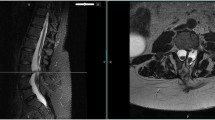Abstract
We present findings obtained from a total of 100 patients who had previously undergone surgery for spina bifida and whose progress had been monitored by magnetic resonance imaging (MRI) in our meningomyelocele clinic. Fourteen of these patients (14.0%) developed delayed symptom(s) of progressive spinal neurologic dysfunction. In those with myeloschisis, increase of motor deficit was the most common clinical manifestation during infancy and early childhood (mean age: 6.8 years), whereas pain on back flexion was seen in patients who were over 15 years of age (mean age: 17.3 years). MRI carried out in myeloschisis patients invariably demonstrated that the conus medullaris was in an abnormally low position, suggesting over-distension of the spinal cord. This was irrespective of whether symptom(s) developed or not and did not correlate with the initial surgical procedure (reconstructive or otherwise) used. Patients with symptom(s) were revealed by MRI to have an extremely low conus set at the spinal level of S-1 or below; neurological examination showed that the motor deficit occurred at high levels in the spine. Results from lipomeningocele patients were more erratic in terms of conus position and delayed development of neurological defects. The authors conclude: (1) that elongation of the spinal cord as an MRI finding seen postoperatively in cases of myeloschisis (radiological finding of a low-placed concus medullaris) does not necessarily imply functional disorder (tethered cord syndrome) and (2) that the pathophysiology of the late onset of progressive neurological deterioration in the spine occurring in patients who have previously undergone lipomeningocele repair may be associated with an invasive or expansile mass effect and should not always be regarded as involving tethered cord syndrome.
Similar content being viewed by others
References
Anderson FM (1975) Occult spinal dysraphism: a series of 73 cases. Pediatrics 55:826–835
Bassett RC (1950) The neurologic deficit associated with lipoma of the cauda equina. Ann Surg 131:109–166
Bruce DA, Schut L (1979) Spinal lipomas in infancy and childhood. Child's Brain 5:192–203
Chapman PH (1982) Congenital intraspinal lipomas. Anatomic considerations and surgical treatment. Child's Brain 9:37–47
Chehrazi B, Haldeman S (1985) Adult onset fibrous diastematomyelia. Neurosurgery 16:681–685
Dubowitz V, Lorber J, Zachary RB (1965) Lipoma of the cauda equina. Arch Dis Child 40:207–213
Emery JL, Lendon RG (1969) Lipomas of the cauda equina and other fatty tumours related to neurospinal dysraphism. Dev Med Child Neurol 20 [Suppl]:62–70
Fitz CR, Harwood-Nash DC (1975) The tethered cord conus. Am J Roentgenol 125:515–523
Garcean GJ (1953) The film terminate syndrome (the cord-traction syndrome). J Bone Joint Surg 35:711–716
Heinz ER, Rosenbaum AE, Scarff TB, Reigel DH, Drayer BP (1979) Tethered spinal cord following meningomyelocele repair. Radiology 131:153–160
Hoffman HJ, Hendrick EB, Humphreys RP (1976) The tethered spinal cord: its protean manifestations, diagnosis and surgical correction. Child's Brain 2:145–155
Hoppenfeld S (1977) Orthopaedic neurology. A diagnostic guide to neurologic levels. Lippincott Toronto
James CCM (1972) Spinal dysraphism. Butterworth, London
James CCM, Lassman LP (1970) Diastematomyelia and the tight filum terminate. J Neurol Sci 10:193–196
James CCM, Lassman LP (1973) Spinal dysraphism. The diagnosis and treatment of progressive lesions in spina bifida occulta. J Bone Joint Surg 44:828–841
James HE, Schut L (1974) The spontaneous remission of a large sacrococcygeal lipomeningocele sac with presentation of a tethered cord syndrome. Neuropädiatrie 5:342–343
Jones PH, Love JG (1956) Tight filum terminate. Arch Surg 73:556–566
Kaplan JO, Quencer RM (1980) The occult tethered conus syndrome in the adult. Neuroradiology 137:387–391
Linder M, Rosenstein J, Sklar FH (1982) Functional improvement after spinal surgery for the dysraphic malformations. Neurosurgery 11:622–624
Matson DD (1969) Neurosurgery of infancy and childhood, 2nd edn. Thomas, Springfield, Ill
McLone DG (1980) Technique for closure of myelomeningocele. Child's Brain 6:65–73
Oi S, Matsumoto S (1986) Magnetic resonance imaging of midline anomalies. J Pediatr Neurosci 2:251–261
Oi S, Shose Y, Okuda Y, Yamada H, Ijichi A, Matsumoto S (1986) Etiopathogenesis of spina bifida — analysis of the pathoembryology in an experimental model with special reference to stage and agent specificity (in Japanese). Shoni No Noshinkei 11:295–305
Oi S, Saya H, Matsumoto S (1988) A hypothesis for myeloschisis: “overgrowth and reopening.” An experimental study. J Neurosurg 68:947–954
Osaka K, Tanimura T, Hirayama A, Matsumoto S (1978) Myelomeningocele before birth. J Neurosurg 49:711–724
Pang D, Wilberger JE Jr (1983) Tethered cord syndrome in adults. J Neurosurg 57:32–47
Rangnasson TS, Durwara OJ, Nordgren RE (1986) Spinal cord tethering after traumatic paraplegia with late neurological deterioration. J Neurosurg 64:397–401
Reigel DH (1982) Spinal bifida. In: American Association of Neurological Surgeons (eds) Pediatric neurosurgery. Grune & Stratton, New York, pp 23–47
Sarwar M, Crelin ES, Kier EL, Varapongse C (1983) Experimental cord stretchability and the tethered cord syndrome. AJNR 4:641–643
Sarwar M, Virapongse C, Bhimani S (1984) Primary tethered cord syndrome: a new hypothesis of its origin. AJNR 5:235–242
Sato K, Shimoji T, Sumie H, Yaguchi K, Yagishita A, Kuru Y, Ishii S (1985) Surgically confirmed myelographic classification of congenital intraspinal lipoma in the lumbosacral region. Child's Nerv Syst 1:3–11
Simon RH, Donaldson JO, Ramsby GR (1981) Tethered spinal cord in adult siblings. Neurosurgery 8:241–244
Tani S, Yamada S, Knighton RS (1987) Extensibility of the lumbar and sacral cord. Pathophysiology of the tethered spinal cord in cats. J Neurosurg 66:116–123
Wortsman J, Chui M, Gray T, Tucker W (1983) Spinal meningeal AVM supplied from the internal lilac artery associated with tethered cord syndrome in an adult: case report. J Can Assoc Radiol 34:323–325
Yamada S, Zinke DE, Sanders D (1981) Pathophysiology of “tethered cord syndrome.” J Neurosurg 54:494–503
Yashon D, Beatty RA (1966) Tethering of the medullaris within the sacrum. J Neurol Neurosurg Psychiatry 29:244–250
Author information
Authors and Affiliations
Rights and permissions
About this article
Cite this article
Oi, S., Yamada, H. & Matsumoto, S. Tethered cord syndrome versus low-placed conus medullaris in an over-distended spinal cord following initial repair for myelodysplasia. Child's Nerv Syst 6, 264–269 (1990). https://doi.org/10.1007/BF00307662
Received:
Issue Date:
DOI: https://doi.org/10.1007/BF00307662




